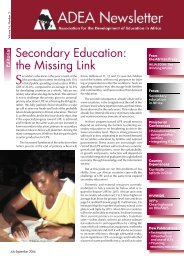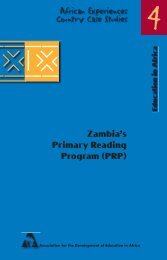Trends in Distance Education and Open Learning: Policy ... - ADEA
Trends in Distance Education and Open Learning: Policy ... - ADEA
Trends in Distance Education and Open Learning: Policy ... - ADEA
You also want an ePaper? Increase the reach of your titles
YUMPU automatically turns print PDFs into web optimized ePapers that Google loves.
Nearly 30% of All Africans SubscribeMasais <strong>in</strong> rural Zanzibar talk<strong>in</strong>g on theirmobile phones © Mart<strong>in</strong> KonzettIn the meantime, the African cont<strong>in</strong>ent has stunned the world by leapfrogg<strong>in</strong>g severalstages of traditional telecommunications development. The mobile phone has becomecommonplace even <strong>in</strong> many of the poorest countries. By 2009, about one third of theAfrican population had a mobile phone subscription – as opposed to only 8.7% us<strong>in</strong>g theInternet through desktop computers (Internet World Stats). With approximately 360million cell phone subscribers, Africa has surpassed the USA (270 million subscribers),accord<strong>in</strong>g to the UN Information Economy Report 2009. And there is still great potentialfor further development.Will future African students, therefore, be learn<strong>in</strong>g from the telephones <strong>in</strong> their pocketsrather than from the laptops <strong>in</strong> their classrooms?N<strong>in</strong>e Key Issues for mLearn<strong>in</strong>g <strong>in</strong> AfricaIn his presentation at the eLA conference, Paul Birevu Muy<strong>in</strong>da from the MakerereUniversity <strong>in</strong> Ug<strong>and</strong>a said that mobile phone learn<strong>in</strong>g (mLearn<strong>in</strong>g) was expected to growrapidly <strong>in</strong> African <strong>in</strong>stitutions of higher education because, <strong>in</strong> the majority of these<strong>in</strong>stitutions, over 90% of the learners owned mobile phones <strong>and</strong> 100% used at least amobile phone service. “These figures augur well for <strong>in</strong>stitutions of higher learn<strong>in</strong>g <strong>in</strong>Africa wish<strong>in</strong>g to adopt <strong>and</strong> implement mLearn<strong>in</strong>g,“ he said.Muy<strong>in</strong>da <strong>and</strong> his colleagues from the Makerere University have proposed a mobilelearn<strong>in</strong>g adoption <strong>and</strong> implementation model for Africa (MLAIMA). It evolved fromanswers to the question “What are the key issues for African countries’ adoption <strong>and</strong>implementation of mLearn<strong>in</strong>g?” The answers formed the basis for construct<strong>in</strong>g themodel us<strong>in</strong>g the Design Research methodology.65
















